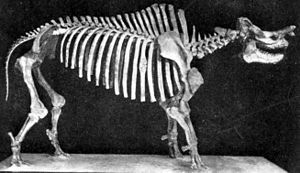Brontotherium
| Brontotherium | ||||||||||||||||
|---|---|---|---|---|---|---|---|---|---|---|---|---|---|---|---|---|
|
Obsolete systematic group The taxon dealt with here is not part of the systematics presented in the German-language Wikipedia. More information can be found in the article text. |
||||||||||||||||

Skeleton reconstruction of " Brontotherium gigas " |
||||||||||||||||
| Temporal occurrence | ||||||||||||||||
| Upper Eocene ( Chadronian ) | ||||||||||||||||
| 38 to 33.9 million years | ||||||||||||||||
| Locations | ||||||||||||||||
| Systematics | ||||||||||||||||
|
||||||||||||||||
| Scientific name | ||||||||||||||||
| Brontotherium | ||||||||||||||||
| Marsh , 1873 | ||||||||||||||||
Brontotherium is a name for a genus of extinct mammals originally described as a separate species , which was assigned to the Brontotheriidae (Brontotherien) from the Palaeogene of North America, a family that isclosely related to today's horses within the odd ungulate . The validity of the genus is largely doubted ( nomen dubium ), since numerous authors today place it as Megacerops . The name Brontotherium was introduced in 1873 by Othniel Charles Marsh and referred to three individuals from the Museum of Natural History at Yale University, proven by skeletal finds. These were originallyclassifiedas Titanotherium , anotherinvalid taxon of the Brontotherium (the latter genus name goes back to Joseph Leidy from 1852, whosuggested that it be Titanotherium due to the enormous size of a fossilassociatedwith the equine Palaeotherium rename.).
The name Brontotherium was used for a long time and was the inspiration for the entire family (originally Titanotheriidae). In 1989, the paleontologist Bryn J. Mader classified the fossils assigned to her, along with others (including Titanops and Titanotherium ), into the genus Megacerops , which Joseph Leidy had established in 1870, three years before Brontotherium . In 2004, Matthew C. Mihlbachler combined other synonym genera such as Brontops and Menops under the same name. Megacerops was characterized by a massive physique comparable to today's rhinos and had a shoulder height of 2.5 m, making it one of the largest members of the Brontotherien at all. It also featured four toes on the front feet and three toes on the hind feet and a pair of horns on the muzzle . The horns did not consist of horny substance or keratin as in comparable formations of today's ungulates , but of bones , the variable shape of the horns, which originally led to the individual descriptions of the species, is, according to Mihlbachler, to be ascribed to a sexual dimorphism within Megacerops .
Individual evidence
- ↑ Joseph Leidy: Description of the remains of extinct Mammalia and Chelonia, from Nebraska territory, collected during the Geological Survey under the direction of Dr. DD Owen. In: David Dale Owen (ed.): Report of a geological survey of Wisconsin, Iowa, and Minnesota and incidentally of a portion of Nebraska Territory. Philadelphia: Lippincott, Grambo, 1852, pp. 534-572 (pp. 551-552) ( online )
- ^ Othniel Charles Marsh: Notice of New Tertiary Mammals. The American Journal of Science and Arts 3 (5), 1873, pp. 485-488 ( online )
- ↑ Bryn J. Mader: Brontotheriidae: A systematic revision and preliminary phylogeny of North American genera. In: Donald R. Prothero and Robert M. Schoch (Eds.): The evolution of perissodactyls. New York and London, 1989, pp. 458-484
- ^ Joseph Leidy: (Description of a new genus and species, Megacerops coloradensis). Proceedings of the Academy of Natural Sciences of Philadelphia 22, 1870, pp. 1-2 ( online )
- ^ Matthew C. Mihlbachler: Species taxonomy, phylogeny, and biogeography of the Brontotheriidae (Mammalia: Perissodactyla). Bulletin of the American Museum of Natural History 311, 2008, pp. 1-475 ( online )